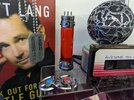Redrocirt
New Member
Hi prop makers,
I have made some custom vials for TNG/DS9/VOY Hyposprays myself (not for sale).
The vials have magnets embedded in the lids so that the vial can be held inside the Hypospray by another magnet.
The custom acrylic lids are permanently attached with PMMA polymerization adhesive.
The vials are filled with distilled water, mixed with food coloring.
Time will tell whether the vials are really sealed or whether the filling will dissolve.

I thought it might be interesting for other prop makers to see how I made the vials, so here's a little video documentation:
This was the first time I worked with a lathe, it was fun and interesting to learn how to use it.
Other things I've learned during this build:
Please feel free to add your experiences and pictures of your hypospray vial replicas below in this thread
I have made some custom vials for TNG/DS9/VOY Hyposprays myself (not for sale).
The vials have magnets embedded in the lids so that the vial can be held inside the Hypospray by another magnet.
The custom acrylic lids are permanently attached with PMMA polymerization adhesive.
The vials are filled with distilled water, mixed with food coloring.
Time will tell whether the vials are really sealed or whether the filling will dissolve.
I thought it might be interesting for other prop makers to see how I made the vials, so here's a little video documentation:
This was the first time I worked with a lathe, it was fun and interesting to learn how to use it.
Other things I've learned during this build:
- Extruded acrylic glass might have visible streaks in the surface, so it's better to use cast acrylic glass for a high quality look
- It is worth trying out different types of adhesive to find the best visual result.
- Don't be afraid of trial and error – I made a bunch of prototypes to test things first and also damaged some or had bad results...
Please feel free to add your experiences and pictures of your hypospray vial replicas below in this thread
Last edited:

